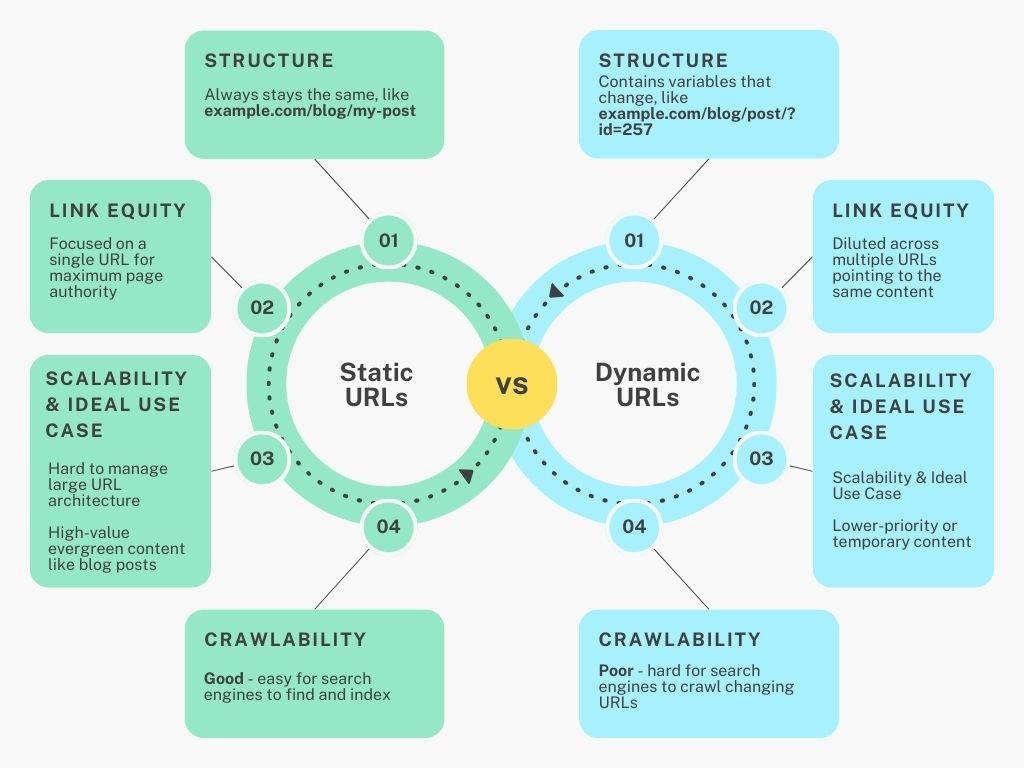Static URLs vs. Dynamic URLs: Which Should You Use for SEO?
This post explores the pros and cons of each URL type. Learn when dynamic URLs make sense and when static is best for rankings and usability.

URLs are like road signs on the information superhighway.
They point search engines and users to the right destination. But not all URLs are created equal. You have two main options: dynamic URLs or static URLs.
Which one should you use for optimal SEO? Let’s take a drive down both routes and see where they lead.
Dynamic URLs: The Flexible Freeway
Dynamic URLs contain variables that change based on user input or other factors. They typically look something like this:
https://www.example.com/blog/post/?id=257
The id number changes depending on which blog post the user wants to see. This allows you to have a single URL structure that pulls up any piece of content.
Key Benefits of Dynamic URLs
Flexibility. You can serve unlimited pages while keeping your site architecture clean and simple. No need to create a new URL for every piece of content.
Future-proofing. If you add new content down the road, you don’t have to update your URLs. The variables automatically adjust.
Personalization. You can display different content for each user by integrating their details into the URL parameters.
Downsides of Dynamic URLs
Crawling challenges. Search engines have a hard time crawling URLs that change constantly or have endless permutations. Important pages may get missed.
Thin content. If you rely too heavily on parameters, each URL contains less descriptive value for search engines to “read” and understand your content.
Canonical issues. The same content can be accessed via multiple dynamic URLs, diluting PageRank. You may need to set a canonical URL.
Lack of branding. Generic-looking URLs with lots of numbers and variables aren’t very enticing to users or search engines.
So dynamic URLs provide technical convenience at the cost of some SEO difficulties. You can optimize them, but it takes extra work.
Static URLs: The SEO Highway
Static URLs always point to the same destination, like this:
https://www.example.com/blog/dynamic-vs-static-urls/
The URL path and file name never change.
Advantages of Static URLs
Human- and search engine-friendly. Static URLs are scannable, memorable, and contain relevant keywords.
Improved crawlability. Search engines can easily index every page without duplicates or dead ends.
Page authority boost. All the link equity for a URL stays focused on one page instead of being diluted across multiple dynamic URLs.
Brand building. A clean URL structure with strategic keywords helps reinforce what your brand does and builds trust.
Roadblocks of Static URLs
Maintenance required. You need to manually update URLs if you change content or add new pages.
Scalability challenges. It’s difficult to build a static URL architecture that can gracefully handle thousands of pages.
Lack of personalization. Static URLs don’t allow for customization based on user attributes or behavior.
Duplicate content risks. If you syndicate content, it’s harder to control distribution with static URLs.
Static URLs may take more work to manage at scale, but they pave a smooth road for search engines when done right.
Overview of Dynamic URLs vs Static URLs
| Dynamic URLs | Static URLs | |
|---|---|---|
| Structure | Contains variables that change, like example.com/blog/post/?id=257 |
Always stays the same, like example.com/blog/my-post |
| Crawlability | Poor - hard for search engines to crawl changing URLs | Good - easy for search engines to find and index |
| Link Equity | Diluted across multiple URLs pointing to the same content | Focused on a single URL for maximum page authority |
| Scalability | Easy to scale to thousands of pages | Hard to manage large URL architecture |
| Branding | Generic, not very enticing | Customized keywords reinforce branding |
| Maintenance | No need to update URLs | Requires updating URLs if content changes |
| Personalization | Can adapt URLs to user attributes | Not customizable |
| Ideal Use Case | Lower-priority or temporary content | High-value evergreen content like blog posts |

The Optimal Route: A Hybrid Approach
Like most things in marketing, the best solution is usually a balance rather than an extreme.
The ideal URL setup combines the advantages of dynamic and static into a hybrid approach:
Static URLs for key pages.
Use descriptive, keyword-rich static URLs for high-value pages like blog posts, product pages, category archives, etc. These are the pages you want search engines to easily find and index.
Dynamic URLs for lower-priority content
Use dynamics URLs for lower-value pages like tagged content, filtered views, pagination, user profiles, etc. They offer flexibility without diluting your core pages.
Canonical tags
Implement canonical tags on pages that can be accessed via multiple URLs to avoid duplicate content issues.
URL redirects
Set up 301 redirects if you need to change or consolidate URLs so search engines and users are sent to the right place.
With this hybrid approach, you get the SEO benefits of static URLs where it matters most while still retaining the versatility of dynamic URLs for lower-priority content. It’s the best of both road systems!
Driving the right amount of qualified traffic to your site requires choosing the optimal URL structure.
Like riding a bike, balancing static stability with dynamic agility takes some practice. But once you find that sweet spot, you’ll be cruising smoothly down the SEO highway.
Read Next
What is local SEO?
Learn what local SEO is, why it’s vital for local businesses, and get 5 tips to improve your local SEO to get found by your customers.
How to Track Your Competitors’ Keywords Using UberSuggest
Uncover the secret to SEO espionage with this comprehensive guide. Learn how to track your competitors’ keywords using UberSuggest and gain an edge in your marketing strategy.
Warning: Your Competitors are Crushing You on SEO and You Don’t Even Know It
Stay ahead of your competitors in the digital world with effective SEO strategies. This blog post highlights the importance of evolving SEO tactics and provides actionable tips to outsmart the competition.”


